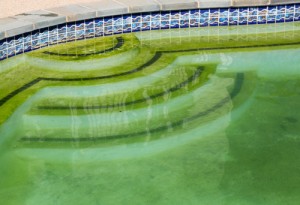If you have a swimming pool, chances are it has happened to you. The start of summer has arrived, the sun is out and the water has warmed up enough for that first swim of the year. You put your swimsuit on, get ready to jump in, and almost fall over backwards as you recoil away from fluorescent green water – water that was crystal clear just a day ago. So what has happened? Algae has decided, like you, that a nice warm pool is a very comfortable place to be.
So what is algae? Put simply it is a very simple photosynthetic organism that lives underwater. It can be many different colors from black to yellow to green, although the most common is green. Algae can live as microscopic organisms suspended in the water and can also attach itself to the surfaces of your pool and form colonies on the sides and bottom of the pool. Left unchecked, algae can do a lot of damage by staining the surfaces in which it attaches itself to.
Logically, the next question is, how did it get into your pool? Why did it show up all of a sudden? Because algae is such a small, simple organism, it is found airborne all around us. Algae is in the air and in the soil all over the place. Because algae is, pretty much, everywhere, it can be common to have an algae bloom in a pool after a heavy rain or windstorm that deposited large amounts in the water.
The good news is that algae is easily prevented and cared for. Even very well maintained pools are subject to an algae bloom if the composition of the water allows for it – algae is able to grow when there is not sufficient biocide (chlorine or bromine) in the water and the water pH is not well balanced. Let’s break down each component:
-
A biocide is what sanitizes the water. It kills living organisms that can make a swimmer sick or affect the quality of the water. Too little sanitizing agent (or “locked up” sanitizers) and organic elements are able to survive in the water. A biocide, such as chlorine or bromine, is measured in two ways (we will use the most common form, chlorine, in our example, but the fundamentals are the same) total chlorine and free chlorine. Total chlorine is the amount of sanitizer in the water. Total chlorine can be very high and algae and other organisms can still be allowed to grow because the chlorine can only sanitize the pool water if it is “free” to do so. Thus free chlorine is the amount of biocide that is available to sanitize the pool. The element chlorine naturally bonds with other elements in the pool water. The most common is ammonia – which comes from sweat, urine and other sources in the water. If the chlorine is all used up by being bonded to other elements, it can’t go around killing algae. Shocking a pool super chlorinates it, neutralizing the ammonia in the water and frees up the chlorine to do what it is supposed to do – sanitize the water.
-
pH is the measure of relative acidity or alkalinity in the water. It can be effected by a high swimmer load (sweating and urinating in the water) or leaves and dirt making it acidic or hard water making it alkaline (base). For a sanitizer to work effectively, the pH must be balanced to a neutral point (between 7.2 and 7.8 for swimming pools). Too acidic of water not only diminishes the effectiveness of biocides, but can also cause the water to become corrosive while to alkaline of water will allow calcium deposits to form on pool walls and on pool equipment.
To summarize the topic at hand – your pool has instantly turned green most likely due to a combination of factors – improperly balanced pH and not enough free chlorine in the water. Of course, this can be caused by neglecting to care for and balance the pool on a regular basis. However, even the most diligent pool chemist can find themselves with an occasional green pool thanks to mother nature. A combination of wind, rain, soil in the pool and temperature can cause an algae bloom overnight.
The best cure for an algae problem is to ensure that the pH is balanced and that there is sufficient free chlorine (between 1 and 3 ppm) to attack the organic matter in the water. Balancing pH and sanitizer levels is typically a much better and more cost effective solution than reactionary algicides which are expensive and typically unnecessary. Of course, ensure that your pool pump and filtration system is running a sufficient amount of time to circulate the water and filter out dead organic materials as well. The typical pump system is designed to be run for 5 to 6 hours in the warm weather months.
Happy swimming in clear, clean water!

